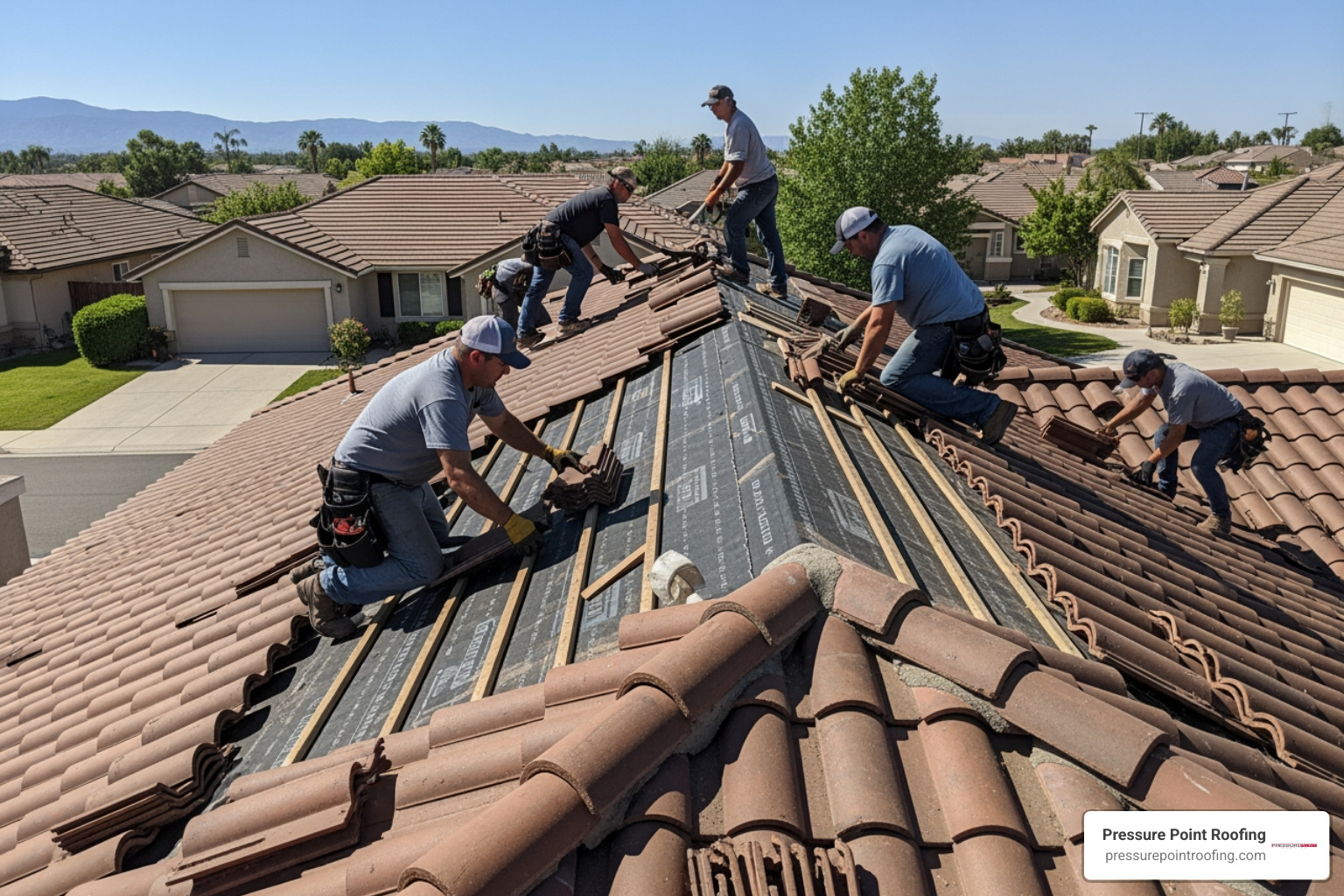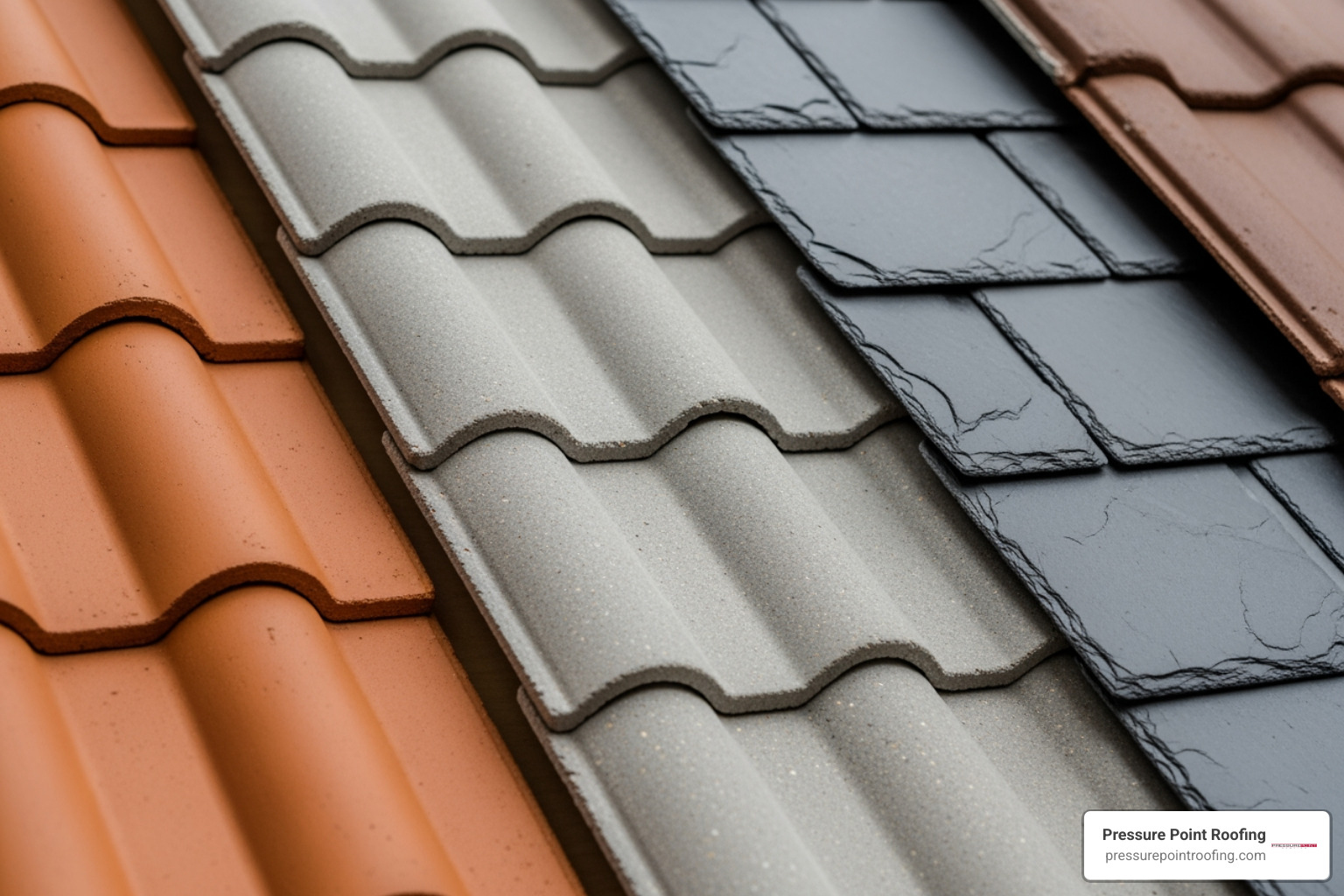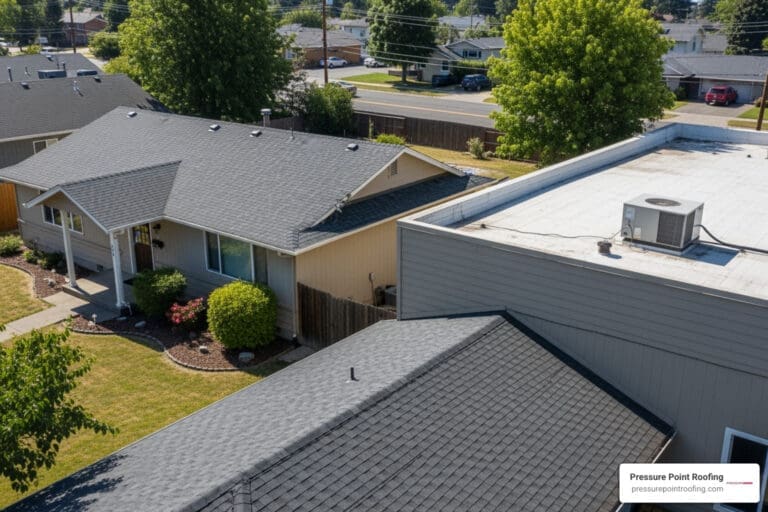How Much to Retile a Roof? A Comprehensive Cost Breakdown
Why Understanding Roof Retile Cost Matters for Your Home
Roof retile cost is one of the most important considerations when planning a major home improvement project. Whether your existing tile roof has reached the end of its lifespan, sustained storm damage, or you’re simply looking to upgrade your home’s appearance and value, understanding what influences the total investment helps you make informed decisions and budget appropriately.
Quick Answer: What Affects Roof Retile Cost?
- Roof size and complexity – Larger roofs and those with steep pitches, multiple valleys, or dormers require more materials and labor
- Tile material choice – Concrete tiles are the most affordable, while slate and terracotta command premium prices
- Labor and installation – Specialized tile installation skills and safety requirements significantly impact total expenses
- Old roof removal – Tearing off and disposing of existing materials adds to the project timeline and budget
- Structural reinforcement – Tile roofs are heavy and may require additional framing support
- Underlayment replacement – This critical waterproofing layer typically needs updating during a full retile
- Geographic location – Regional labor rates and material availability vary across the Pacific Northwest and Northern California
Whether you’re in Oregon, Southern Washington, or Northern California, tile roofs remain a popular choice for their exceptional durability, energy efficiency, and timeless aesthetic appeal. While the upfront investment is higher than asphalt shingles, a properly installed tile roof can last 50 to 100 years or more, making it one of the most cost-effective roofing solutions over the long term. However, tile installation requires specialized expertise, careful planning, and an understanding of the many factors that influence the final price.
I’m Larry Sykes, Director of Sales and Marketing at Pressure Point Roofing, and I’ve spent over 38 years in the roofing industry helping homeowners steer major decisions like understanding roof retile cost and choosing the right materials for their homes. Throughout this guide, I’ll break down everything you need to know to plan your tile roofing project with confidence.

Key Factors That Influence Your Roof Retile Cost
Planning a tile roof replacement is exciting—it’s a significant investment that will protect and beautify your home for decades to come. But naturally, you want to understand what shapes your roof retile cost before diving in. While every home is unique and we can’t quote specific numbers without seeing your property, we can walk you through the key elements that influence what you’ll invest. Think of this as your roadmap to understanding the project ahead.
Let’s start with the most straightforward factor: your roof’s size and square footage. It’s simple math, really—a larger roof needs more tiles, more underlayment, more flashing, and more time to install. If you’ve got a sprawling ranch-style home, you’ll naturally invest more than someone with a cozy cottage. But size is just the beginning of the story.
The pitch and complexity of your roof can have an even bigger impact on your roof retile cost than square footage alone. A steeply pitched roof—the kind that makes your home look dramatic and architectural—requires specialized equipment, extra safety measures, and considerably more time to work on safely. And if your roof has multiple valleys, dormers, hips, or intricate angles (those beautiful architectural details that give your home character), each one adds complexity to the installation. Our crews need to carefully cut and fit tiles around these features, which takes skill, patience, and time.
Geographic location plays a role too. We serve communities throughout Oregon, Southern Washington, and Northern California—from Grants Pass to Klamath Falls, Central Point to Gold Beach—and labor availability, material transportation, and even local building requirements can vary from one area to another. Your specific location within our service region influences these practical considerations.
Labor rates reflect the specialized expertise that tile installation demands. This isn’t a cookie-cutter roofing job—it requires craftspeople who understand the nuances of working with heavy, individual tiles and creating a weather-tight system that will last for generations. The demand for skilled roofing professionals in your area naturally influences this component of your investment.

Before we can install beautiful new tiles, we need to address what’s already there. Old roof removal and disposal is a significant part of the process. We carefully strip away your existing roofing materials—whether that’s worn-out tiles, old shingles, or another material—and dispose of everything responsibly. This phase is labor-intensive and time-consuming, especially if your current roof has multiple layers or is particularly heavy. The accessibility of your property matters here too—a roof that’s easy to reach with equipment and disposal trucks is simpler to work on than one with challenging access.
Once we’ve removed the old roof, we sometimes find that structural reinforcement is necessary. Here’s something many homeowners don’t realize: tile roofs are heavy. Clay and concrete tiles weigh significantly more than asphalt shingles or other common roofing materials. If your home’s framing wasn’t originally designed to support this weight—perhaps you’re switching from a lighter material to tile—we’ll need to reinforce the structure to safely carry the load. This ensures your home remains safe and your beautiful new roof performs as it should for decades. While this adds to your roof retile cost, it’s an essential investment in your home’s structural integrity.
Understanding labor’s contribution
There’s a reason tile roofing is considered a specialized trade—it’s genuinely an art form that requires years of experience to master. The labor component of your roof retile cost reflects this expertise, and it’s worth understanding why.
Specialized skills for tile installation set experienced roofers apart from general contractors. Each tile must be carefully handled (they can break if dropped or mishandled), precisely aligned, and properly secured. Our crews often need to custom-cut tiles to fit around vents, chimneys, valleys, and roof edges. It’s meticulous work that requires a trained eye and steady hands. When you hire professionals with these specialized skills for tile, you’re ensuring that every tile is positioned correctly, fastened securely, and that your entire roof functions as one cohesive, weather-resistant system. This craftsmanship is what gives you a roof that lasts 50, 75, even 100 years.
The installation time for a tile roof is longer than you might expect if you’re used to watching asphalt shingle installations. That’s because each individual tile is placed and fastened by hand—there’s no shortcut to quality. A complex roof with multiple dormers, valleys, and features naturally takes longer than a simple rectangular design. Weather conditions in the Pacific Northwest can extend timelines too—we won’t rush work during rain or high winds because doing it right matters more than doing it fast.
Safety precautions are absolutely non-negotiable when working on roofs, especially steep ones with heavy materials. Our crews use specialized harnesses, scaffolding, and equipment to protect themselves and your property throughout the project. We follow strict safety protocols because we care about our team members going home safely every day—and because proper safety measures also protect your home from accidental damage. These necessary precautions are built into the labor investment, and honestly, you wouldn’t want it any other way.
We believe that a well-trained, safety-conscious crew delivers better results every time. The expertise and qualifications of your roofing team directly impact the quality and longevity of your roof. If you’re curious about what makes a skilled roofer, our article on Roofer Qualifications offers helpful insights.
Additional factors affecting your roof retile cost
Beyond the major elements we’ve discussed, several other considerations can influence your final roof retile cost. Being aware of these helps you budget realistically and avoid surprises.
Permits and inspection fees are required for virtually all roof replacement projects in Oregon, Southern Washington, and Northern California. Local building departments require permits to ensure your new roof meets current safety codes and structural standards. These fees cover the administrative work and necessary inspections by local authorities. While nobody loves paying fees, these requirements exist to protect you—they ensure your roof is installed correctly and will perform safely for years to come.
Underlayment replacement is one of those hidden heroes of your roofing system. This waterproof barrier sits directly on your roof decking, beneath your beautiful tiles, and serves as the critical last line of defense against moisture. When we’re replacing your tile roof, we typically replace the underlayment too—it’s the smart approach since the old underlayment has likely reached the end of its lifespan along with your tiles. Installing high-quality underlayment adds to both the material and labor portions of your project, but it’s absolutely essential for a roof system that performs properly.
Sometimes a roof replacement project reveals that your roof decking—the wooden foundation layer beneath everything else—has damage from water intrusion, age, or wear. If we find compromised decking during tearoff, addressing it isn’t optional. Your new roof needs a solid foundation to perform correctly. Our article Roof Decking Damage: Should You Repair or Replace? explores this important topic in more detail.
If your gutters are showing their age, your roof replacement might be the perfect time to upgrade them too. Old, sagging, or undersized gutters won’t properly handle the runoff from your new tile roof, potentially causing water damage down the line. Coordinating gutter work with your roof replacement is often more efficient and cost-effective than tackling it as a separate project later. We discuss the advantages of this approach in Should Roofing and Gutters Be Replaced at the Same Time?
Finally, anywhere your roof intersects with another structure—chimneys, skylights, vents, or walls—requires specialized chimney or skylight flashing to prevent leaks. This metal flashing creates a watertight seal around these penetrations. If your existing flashing is corroded, improperly installed, or simply old, replacing it during your retiling project ensures a completely leak-free system. This detailed work requires skill and adds to both the material requirements and installation complexity of your project, but it’s what separates a good roof from a great one that truly protects your home.
Comparing Tile Materials: Lifespan and Aesthetics
Choosing the right tile material isn’t just about picking a color you like—it’s one of the most important decisions you’ll make during your roofing project. The material you select directly impacts your roof retile cost, your home’s curb appeal, and how well your roof stands up to decades of Pacific Northwest weather.

When we talk with homeowners about tile options, material weight considerations are always at the top of our list. Clay and concrete tiles are significantly heavier than asphalt shingles—sometimes weighing two to three times as much per square foot. This weight isn’t necessarily a bad thing; it means your roof is incredibly durable and resistant to wind damage. However, it also means your home’s structure needs to be strong enough to support that load. As we mentioned earlier, this is where structural reinforcement sometimes comes into play, adding to your overall investment but ensuring your roof is safe and secure for generations.
Climate suitability matters tremendously in our service areas spanning Oregon, Southern Washington, and Northern California. We experience everything from coastal fog and rain to dry summers and occasional freezing temperatures. Some tile materials thrive in warm, dry climates, while others handle freeze-thaw cycles with ease. Clay tiles, for instance, perform beautifully in warm regions but can be susceptible to cracking in areas with harsh winter conditions. Concrete tiles offer more versatility across different climates, making them a popular choice throughout our region.
The aesthetic impact of your tile choice can’t be overstated either. The right tile transforms your home’s entire appearance, and the color you choose affects more than just looks—it influences your home’s energy efficiency too. Lighter colors reflect heat, keeping your home cooler in summer, while darker tones absorb warmth. Our article on Roofing Color explores this topic in greater depth.
Here’s how the most common tile materials compare:
| Tile Type | Lifespan | Pros | Cons |
|---|---|---|---|
| Clay | 50-100+ years | Natural, earthy aesthetic; Fire-resistant; Excellent durability; Energy-efficient | Heavy; Higher upfront cost; Can crack in freeze-thaw cycles |
| Concrete | 40-75 years | Versatile styles and colors; More affordable than clay; Good durability | Heavier than asphalt; Requires periodic maintenance; Can fade |
| Slate | 75-200 years | Premium appearance; Exceptional longevity; Best durability | Very heavy; Highest cost; Requires specialized installation |
| Terracotta | 50-100+ years | Classic Mediterranean look; Natural insulation; Fire-resistant; Ages beautifully | Heavy; Premium pricing; Limited color options |
Clay and Terracotta Tiles
Clay and terracotta tiles bring a timeless, natural beauty that homeowners absolutely love. These tiles have graced roofs for centuries, and there’s a good reason they’ve remained popular—they’re stunning and incredibly durable.
The aesthetic appeal of clay and terracotta is best. That warm, earthy tone adds character and elegance to any home style, from Spanish Colonial to contemporary designs. As these tiles age, they develop a beautiful patina that only improves their appearance over time. Unlike manufactured materials that might look worn as they age, clay tiles become more distinguished.
In terms of durability in warm climates, clay and terracotta truly shine. These materials are naturally fire-resistant, an important consideration in our region where wildfire risk is a reality. They also provide excellent thermal mass, meaning they absorb heat during the day and release it slowly at night, helping keep your home naturally cooler during those hot summer months.
Installation considerations for clay tiles require specialized expertise. These tiles are brittle and need careful handling during installation to prevent cracking. Our experienced crews know exactly how to work with clay—from proper underlayment selection to precise fastening techniques. The weight of clay tiles means we always assess your roof structure first, and we often recommend reinforcement to ensure everything is built to last. Following best practices like those outlined in our guide 4 Most Important Ways to Ensure Your Roof Lasts helps maximize the lifespan of these beautiful tiles.
Concrete Tiles
Concrete tiles offer an excellent middle ground between affordability and performance, making them one of the most popular choices for homeowners in our service areas.
The style versatility of concrete tiles is remarkable. Modern manufacturing techniques allow concrete tiles to mimic the appearance of clay, slate, or even wood shakes, giving you premium aesthetics without the premium price tag. You’ll find concrete tiles in virtually any color you can imagine, from traditional earth tones to contemporary grays and even bold accent colors. This flexibility means you can achieve the exact look you want for your home.
Like all roofing materials, concrete tiles have maintenance needs that homeowners should understand. Over time, the surface can accumulate moss, algae, or debris, especially in our wetter climates. Regular cleaning helps maintain both appearance and performance. The good news is that proper maintenance is straightforward, and we’ve put together helpful information in our article Clean Your Roof to guide you through the process. With proper care, concrete tiles remain beautiful and functional for decades.
Concrete tiles are also more forgiving than clay during installation and less prone to cracking from impacts, making them a practical choice for homes near trees or in areas prone to hail.
Slate Tiles
If you’re looking for the absolute pinnacle of roofing materials, slate tiles represent the premium material in the industry. A slate roof is a true investment in your home’s future.
The best lifespan in the roofing industry belongs to slate, hands down. While most roofing materials are measured in decades, slate is measured in centuries. A properly installed slate roof can last 75 to 200 years or more. Think about that—your great-great-grandchildren could be living under the same roof you install today. This extraordinary longevity means that despite the higher initial investment, slate often proves cost-effective when you consider the total lifespan.
Slate offers best natural beauty with unique color variations and textures that manufactured materials simply cannot replicate. Each tile is one-of-a-kind, creating a roof that’s as individual as your home. Slate is also incredibly fire-resistant and virtually impervious to weather damage.
However, structural requirements for slate are substantial. This is the heaviest roofing material available, and not every home can support its weight without significant reinforcement. Before recommending slate, we always conduct a thorough structural assessment. If reinforcement is needed, it must be done correctly by experienced professionals. The installation itself requires specialized skills—slate tiles must be carefully selected, cut, and fastened using techniques that have been refined over centuries.
When properly installed on a structurally sound home, a slate roof becomes a defining architectural feature that adds tremendous value and distinction to your property.
Schedule a Consultation
By submitting this form, I agree to receive calls and text messages (including those sent using automated technology) from Pressure Point Roofing, LLC and its representatives at the number provided. Message and data rates may apply. Message frequency may vary. Consent is not required as a condition of purchase. Reply STOP to unsubscribe at any time.
Related Content
Partners and Awards












